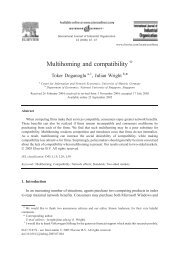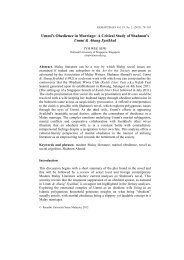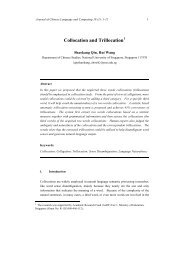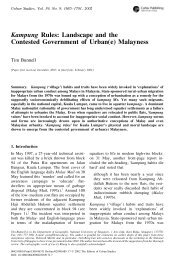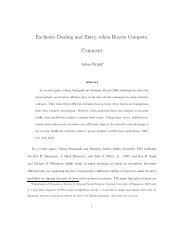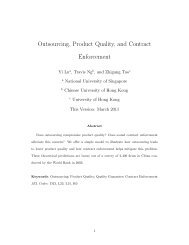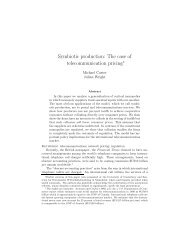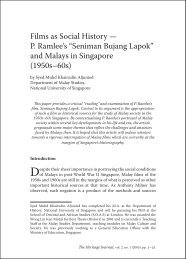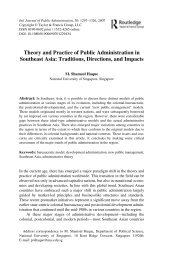Supplementary Appendix for Exclusive dealing with ... - NUS - Home
Supplementary Appendix for Exclusive dealing with ... - NUS - Home
Supplementary Appendix for Exclusive dealing with ... - NUS - Home
Create successful ePaper yourself
Turn your PDF publications into a flip-book with our unique Google optimized e-Paper software.
<strong>Supplementary</strong> <strong>Appendix</strong><strong>for</strong><strong>Exclusive</strong> <strong>dealing</strong> <strong>with</strong> network effectsToker Doganoglu †Julian Wright ‡† Department of Business and Economics, University of Southern Denmark, Odense, Denmark and Faculty ofArts and Sciences, Sabanci University, Turkey.‡ Contact author. Department of Economics, National University of Singapore: e-mail: jwright@nus.edu.sg.
when these offers are non-exclusive.Proposition S-1 When neither firm can offer exclusive deals at either stage, multihoming ispossible and α ≥ c, then no one buys from the incumbent in stage 1; in stage 2 they all buy, butonly from the entrant. This is true even if the incumbent can limit the number of consumers whocan obtain its first stage offers. The outcome is efficient. On the other hand, whenever α < c,the incumbent will sell nonexclusively to ¯n ∗ 1 = α+βc+βconsumers in the first stage, and make all thesales to the remaining consumers in the second stage at a price of c+β. The entrant cannot makeany sales and the outcome is inefficient.As can be seen from the proposition above, <strong>for</strong> sufficiently low values of the marginal cost c,having the possibility of making introductory offers is not sufficient <strong>for</strong> the incumbent to profitablyblock a more efficient from making sales. However, <strong>for</strong> larger values of c, the incumbent can blocksales to a more efficient entrant profitably, by selling introductory deals to sufficiently manyconsumers in the first stage.Next consider the model where exclusive deals are allowed. Since lemma 1 and proposition 1in the main paper are <strong>for</strong>mulated <strong>with</strong> v > c > 0, they continue to apply. This, in turn, impliesthat when exclusive deals are allowed there is a subgame perfect equilibrium where both firms useexclusive deals in either stage, and the incumbent makes all the sales. That is, the singlehomingequilibrium we presented in proposition 3 of the main paper continue to exist.Now, let us investigate the second stage competition between the firms assuming that n 1consumers accepted an exclusive offer from the incumbent in the first stage. Moreover, supposethat both firms use nonexclusive offers in the second stage. In this case, since only unattachedconsumers have a choice to make in stage 2, there are only four possible consistent demandconfigurations: unattached consumers multihome (configuration M) if p I ≤ βn 1 and p E ≤ α(1 −n 1 ); unattached consumers buy from I (configuration I) if p I ≤ min(p E + β,v + β) and p E ≥ 0;unattached consumers buy from E (configuration E) if p I ≥ βn 1 and p E ≤ (α + β)(1 − n 1 ) +min(p I − βn 1 ,v); and finally, unattached consumers do not buy from either firm (configurationØ) when p I > v + βn 1 and p E > v.Whenever multihoming is an equilibrium, it also yields the highest joint surplus, and thuswill be selected by optimally coordinating consumers—the unattached consumers, in this case.On the other hand, whenever multihoming is not an equilibrium and both configurations I andE are consistent demand configurations, optimal coordinators buy from E whenever p E ≤ (α +β)(1 − n 1 ) − β + p I , and I otherwise. The selected configurations define demand uniquely <strong>for</strong>given prices.Given these demands, it is straight<strong>for</strong>ward to see that the unique equilibrium <strong>with</strong> nonexclusiveoffers in the second stage arises when p I = βn 1 and p E = α(1 − n 1 ), provided boththese quantities are larger than the marginal cost, c. At these prices, a price cut does not increasethe demand faced by a firm, while a price increase implies the loss of all demand. For anypair of prices in the multihoming region a firm would find it profitable to increase its price tothe equilibrium level. For prices outside the multihoming region, one of the firms always wouldreduce its price until it moves inside the multihoming region or obtains all the demand from theunattached consumers.As mentioned above, <strong>for</strong> this equilibrium to exist, we need both prices to exceed the marginalcost. It is clear that <strong>for</strong> some values of n 1 this would not be the case. For the incumbent’s priceto be above the marginal cost level, we need n 1 ≥ c β = nL 1 while <strong>for</strong> the entrant’s price to behigher than marginal cost we need n 1 ≤ 1 − c α = nU 1 . Thus, <strong>for</strong> the firms to obtain positive profitsS–3
under multihoming, it is necessary that n L 1 ≤ nU αβ1 , or equivalently c ≤α+β. Note that, wheneverc ≤αβα+β , nL 1 ≤ ¯n 1 =αα+β ≤ nU 1 . Thus <strong>for</strong> n 1 > n U 1 , the incumbent will make all the sales at aprice p I = c + β − (α + β)(1 − n 1 ) while the entrant charges p E = c, regardless of these pricesbeing exclusive or non-exclusive. On the other hand, <strong>for</strong> n 1 < n L 1 , the entrant will make all thesales at a price p E = c + (α + β)(1 − n 1 ) − β while the incumbent charges p I = c, regardless ofbeing exclusive or nonexclusive. There<strong>for</strong>e, to make sales at all in the second stage the incumbentmust select n 1 > n L 1 in the first period. We can write the profit function of the incumbent as afunction of n 1 when c ≤ αβα+βas follows⎧⎪⎨0, n 1 < n L 1π I (n 1 ) = (βn 1 − c)(1 − n 1 ) ≡ f(n 1 ), n L 1⎪⎩≤ n 1 ≤ n U 1(β − (α + β)(1 − n 1 ))(1 − n 1 ) ≡ g(n 1 ), n U 1 < n 1 ≤ 1.It is easy to verify that f(n 1 ) obtains its unconstrained maximum at ˆn 1 = 1 2 + c2β and g(n 1)obtains its unconstrained maximum at n ∗ 1 = 1 2 + α2(α+β) . Whenever, c ≤ αβ2(α+β) ≡ c 1, it is easy toverify that n ∗ 1 ≤ nU 1 , and g(n 1) is decreasing in n 1 at n 1 = n U 1 . Moreover, <strong>for</strong> c ≤ c 1, ˆn 1 ≤ n U 1 ,thus π I (n 1 ) is maximized at ˆn 1 . For c 1 < c nU 1 , hence the profitmaximizing choice of the incumbent can be found by comparing f(ˆn 1 ) and g(n√ ∗ 1 ). Straight<strong>for</strong>wardbut cumbersome algebra confirms that f(ˆn 1 ) ≥ g(n ∗ 1 ) whenever c ≤ β( 1 − βα+β)≡ c2 . Notethat c 1 ≤ c 2 ≤αβ2β+α ≡ c 3. For c 2 < c ≤ c 3 , we have f(ˆn 1 ) ≤ g(n ∗ 1 ), thus π I(n 1 ) is maximizedat n ∗ 1 . Furthermore, f(n 1) is increasing at n 1 = n U 1 and n∗ 1 ≥ nU 1 whenever c ≥ c 3. Thus, <strong>for</strong>c ≥ c 3 , the incumbent’s profit, π I (n 1 ), is maximized at n ∗ 1 . The firms may deviate by switching toexclusive prices when the rival is charging a non-exclusive price. Whenever the first stage choiceof the incumbent is n ∗ 1 and c > c 2, then regardless of the nature of the prices, the second stageequilibrium involves singlehoming. Hence, no firm can profit by switching to a exclusive price.When the first stage choice of the incumbent is ˆn 1 , neither firm can increase its profit by switchingto an exclusive price as the highest price the incumbent can charge exclusively is p I = βˆn 1 , whilethe highest exclusive price the entrant can charge is p E = α(1 − ˆn 1 ).Let us summarize the results above. Suppose c ≤αβα+β . Whenever c ≤ c 2, the profit of theincumbent is maximized by selling ˆn 1 = 1 2 + c2βconsumers an exclusive deal in the first stage, andallowing the remaining 1 − ˆn 1 consumers to multihome by paying p I = βˆn 1 and p E = α(1 − ˆn 1 ).When c 2 < c ≤αβα+β , the profit of the incumbent is maximized by selling n∗ 1 = 1 2 + α2(α+β)consumers an exclusive deal in the first stage, and then the incumbent sells to all the remainingconsumers charging a price p I = c + β 2 .Since depending on the value of the marginal cost, c, the cases that need to be considered arenumerous, we will restrict our attention to the case where c < αβα+β. In this case, the incumbentcannot make any sales in the second stage unless it makes its first stage offers exclusive, sinceaccording to proposition S-1 all the second stage sales will be made by the entrant if the first stageoffers were non-exclusive. Furthermore, ¯n 1 ≥ ˆn 1 if c ≤ (α−β)βα+β. We can thus state the followingproposition regarding the subgame perfect equilbria of the full game:Proposition S-2 When firms can employ exclusive deals, consumers can multihome, the incumbentcan limit the number of consumers who can obtain its first stage offers and c ≤αβα+β , theincumbent will always use exclusive first stage offers.There are two possible subgame perfect exclusive <strong>dealing</strong> equilibria:S–4
a. Singlehoming equilibrium: The incumbent offers an exclusive deal to n ∗ 1 > ¯n 1 consumersin stage 1. In stage 2 equilibrium prices are p ∗ I = c + β 2 and p∗ E= c, <strong>with</strong> both firmsmaking their offers exclusive. The incumbent sells to all consumers.b. Multihoming equilibrium: The incumbent offers an exclusive deal to ˆn 1 = 1 2 + c2β ofthe consumers in stage 1. In stage 2 equilibrium prices are p ∗ I = βˆn 1 and p ∗ E = α(1 − ˆn 1 ),<strong>with</strong> both firms making their offers non-exclusive. All unattached consumers multihome instage 2.Define c 2 = ( √1 − βα+β). Whenever c > c2 , the unique subgame perfect equilibrium is the singlehomingequilibrium. Whenever c ≤ c 2 and c ≤ (α−β)βα+β, then the multihoming equilibrium is theunique subgame perfect equilibrium. Finally, whenever c ≤ c 2 but c > (α−β)βα+β, both singlehomingand multihoming equilibria arise as subgame perfect equilibrium outcomes.As can be seen from the proposition above, <strong>for</strong> sufficiently small values of c (namely c < c 2 )multihoming in the second stage arises as a subgame perfect equilibrium outcome. However,<strong>for</strong> larger values of the marginal cost, one cannot sustain multihoming in equilibrium, and thusregardless of the nature of the second period prices, the incumbent can make all the second stagesales by selling exclusive deals to sufficiently many consumers in the first stage.S–4 Proof of robustness <strong>with</strong> asymmetries in stand-alone benefitsIn this subsection, we show that asymmetries in stand-alone benefits yield qualitatively similarresults to those in our main paper, where asymmetries were instead in marginal network benefits.Focusing on our one-sided model, we consider a variant of our model where both I and E offerthe same marginal network benefits but that E’s product provides a higher stand-alone benefit.Specifically, we assume that both firms offer a network benefit given by βx when x consumerssubscribe to its network. We assume that I’s product delivers a utility only due to network effects,and as a result has a stand-alone benefit normalized to zero. On the other hand, E’s productoffers a positive stand-alone benefit v E , which consumers receive if they subscribe to E’s network.The rest of the model is assumed to remain the same as in the main text.Let us first consider the case where the incumbent has made exclusive sales to n 1 consumers inthe first stage, and characterize the equilibrium outcome in the second stage competition assumingmultihoming is not possible (this also covers the case where at least one firm offers an exclusiveprice in stage 2). In this case, there are 1 − n 1 free consumers which either buy from the entrantor the incumbent.We can then characterize the second stage equilibrium outcome <strong>with</strong> at least one firm offeringan exclusive price as follows.Lemma S-1 Define ñ 1 = v Eβ. Suppose multihoming is not possible. If n 1 > ñ 1 , then the incumbentmakes all the sales in stage 2 and the equilibrium prices are given by p I = −v E + βn 1and p E = 0. If, on the other hand, n 1 ≤ ñ 1 , then the entrant makes all the sales in stage 2 andequilibrium prices are p I = 0 and p E = v E − βn 1 .Proof. As long as β − p I > v E − p E , buying from I is a rational demand configuration. On theother hand, whenever v E + β(1 − n 1 ) − p E > βn 1 − p I , it is rational <strong>for</strong> all free consumers tobuy from E. Optimal coordinators will buy from E whenever v E + β(1 − n 1 ) − p E ≥ β − p I , orequivalently, p E ≤ v E − βn 1 + p I . This <strong>for</strong>mulation implies that whenever v E − βn 1 ≥ 0, it isS–5
E that has a competitive advantage (<strong>with</strong> I’s price driven down to cost), while the competitiveadvantage belongs to I otherwise (<strong>with</strong> E’s price driven down to cost). The prices in the lemmathen follow from the Bertrand-like competition. As a result, I can make sales in the second periodonly when n 1 > ñ 1 .Given this result, we can turn our attention to the first stage. Clearly, I will make an introductory/exclusiveoffer to n 1 > ñ 1 consumers in order to make sales in the second stage. Inorder <strong>for</strong> this to be possible, we need the stand-alone surplus of E to be not too large. Namely,it is necessary that v E ≤ β, since otherwise, whatever the size of the consumer population whichpurchases exclusively from I in the first stage, all the optimally coordinating free consumers willbuy from E in the second stage. Here, we can state a proposition that is parallel to proposition1 in the main paper.Proposition S-3 Assume v E < β. If multihoming is not possible and the incumbent can limit thenumber of consumers buying in stage 1, then n ∗ 1 = 1 2 + v E2βconsumers will buy from the incumbentin stage 1 at the price p 1 = 0, and the rest of the consumers will buy from the incumbent in stage2 at the price p I = β−v E2. The entrant makes no sales. The outcome is inefficient.Proof. If consumers who are offered an exclusive deal in the first stage reject the offer of I, theywill all buy from E and obtain a surplus of β. Buying from I in the first stage exclusively yieldsa surplus of β − p 1 . There<strong>for</strong>e, <strong>for</strong> I’s offer to be accepted, it must be that p 1 ≤ 0. Hence, Iwill make sales to n 1 > ñ 1 consumers in the first stage at a zero price, and sell to the remainingconsumers in the second stage at a price of βn X − v E . The profit of following this strategy isgiven by (βn X − v E )(1 − n X ) and is maximized byn ∗ 1 = 1 2 + ñ12which is less than one whenever ñ 1 < 1. Note also that as long as v E < β, n ∗ 1 > ñ 1.If both firms employ non-exclusive prices in the second stage, then a possibility <strong>for</strong> multihomingarises. However, depending on the nature of first period contracts, there are several possiblemultihoming scenarios. The first one requires I to make introductory but non-exclusive offers ton 1 consumers in the first stage. Let us first characterize the demand as a function of both prices,and then determine the equilibrium prices in stage 2. We restrict our attention to non-negativeprices given a negative price will imply a firm makes a loss in stage 2. Following similar argumentsas in the proof of proposition 2, one can show that both attached and unattached consumers buyfrom E if p E ≤ v E + (1 − n 1 )p I and the unattached consumers buy from I while the attachedconsumers do not buy otherwise. If p I > β and p E > v E + β (1 − n 1 ), then the only consistentdemand configuration is the one where neither the attached nor the unattached buy from eitherfirm. This defines demand uniquely <strong>for</strong> any given set of prices. Given this demand, I charging aprice of zero, p I = 0, while E charging its stand-alone benefit advantage, p E = v E , constitutes asecond stage equilibrium outcome. In equilibrium, I makes zero profits while E obtains a profitof v E . Note that this is an equilibrium outcome regardless of the size of n 1 . All consumers obtaina surplus of β.Now consider consumers deciding whether to buy from I in stage 1. If they do not do so,they know they can get a surplus of β buying from E in stage 2. The best each consumer can dobuying from I is if they all do so, which will only make them better off if p 1 < 0. However, thisimplies a loss <strong>for</strong> I, thus it will not make such an offer and no one will buy from I in either stage.The equilibrium outcome is efficient in this case. Thus, the statement we made in propositionS–6
2 remains true even when the asymmetry between the net benefits offered by I and E is due todifferences in stand-alone values.Proposition S-4 When neither firm can offer exclusive deals at either stage and multihoming ispossible, then no one buys from the incumbent in stage 1; in stage 2 they all buy, but only fromthe entrant. This is true even if the incumbent can limit the number of consumers who can obtainits first stage offers. The outcome is efficient.Given that introductory offers cannot help I, there is a genuine role <strong>for</strong> exclusive deals whenE offers a product that has a higher stand-alone value, just as in the main text where E insteadoffers a higher marginal network benefit. To explore this, let us suppose that n 1 consumers haveaccepted an exclusive deal from I in the first stage. In this case, only the free consumers canmake a choice in the second stage, while the attached consumers are prohibited to consider anyoffer from E due to the exclusivity clause. An immediate result is that, by selling to n 1 > ñ 1consumers, and offering an exclusive price in the second stage, I can make all the sales. Thus,there exists a subgame perfect equilibrium, where I optimally sells through an exclusive dealto n ∗ 1 = 1 2 + ñ12consumers, and the remaining 1 − n ∗ 1 consumers also buy from I at a pricep I = βn ∗ 1 − v E = β−v E2> 0, whenever β > v E due to lemma S-1.However, as in the main text, there exists another second stage equilibrium where the freeconsumers are allowed to multihome. Given that the attached consumers are bound by exclusivedeals to I, free consumers in the second stage can buy from I only, E only or multihome. Freeconsumers multihoming is a consistent demand configuration whenever p I ≤ βn 1 and p E ≤ v E .Whenever p I > βn 1 and p E ≤ v E + β(1 − n 1 ) there is a consistent demand configuration wherethe free consumers buy only from E. On the other hand, whenever p E > v E and p I ≤ β, allfree consumers buying from I constitutes a consistent demand configuration. Note once againthat, whenever multihoming is a consistent demand configuration, optimally coordinating consumerscoordinate on this equilibrium. For prices where multihoming ceases to be an equilibrium,consumers coordinate on the equilibrium where they all buy from E wheneverp E ≤ v E − βn X + p I(S-1)and I otherwise.Suppose E charges p E = v E non-exclusively in stage 2 and consider I’s options. I can chargep I = βn 1 non-exclusively inducing all consumers to multihome. Clearly, I cannot increase itsprofits by reducing its price from this level. On the other hand, increasing its price beyond thisimplies that everybody will just buy from E. Hence, the best non-exclusive response of I againstE’s non-exclusive price is to charge p I = βn 1 . Alternatively, I can consider charging an exclusivesecond period price. I can sell to all free consumers using an exclusive price whenever this pricesatisfies p I < βn 1 . Such a deviation yields a profit that is no higher than it obtains <strong>with</strong> thenon-exclusive price p I = βn 1 . Now assume I charges p I = βn 1 non-exclusively and considerE’s options. Clearly, by charging a non-exclusive price p E ≤ v E , the entrant can induce all freeconsumers to multihome, and hence its optimal price in the multihoming region is p E = v E . If Echarges a higher price, then all the free consumers will purchase from I, making such a deviationnot profitable. The best exclusive offer E can make is to sell to all free consumers exclusively <strong>for</strong>p E = v E . Obviously, E is indifferent between charging a price of p E = v E exclusively or nonexclusively.There<strong>for</strong>e, the non-exlusive offers <strong>with</strong> prices p I = βn 1 and p E = v E is an equilibriumoutcome of the second stage competition. All free consumers multihome.S–7
Expecting the second stage equilibrium to be the multihoming equilibrium <strong>with</strong> non-exclusiveprices, consumers facing an exclusive offer in the first stage demand at least a surplus of β, asurplus which they would obtain if they collectively rejected I’s offer and bought from E inthe second stage. There<strong>for</strong>e the first stage offer of I must satisfy β − p 1 ≥ β to be accepted.Consequently, I will make exclusive offers to n 1 consumers at a zero price and sell its subscriptionsnon-exclusively in the second stage at a price of p I = βn 1 . The profit of this strategy is βn 1 (1−n 1 ),which is maximized whenever n ∗ 1 = 1 2. There<strong>for</strong>e, there exists another subgame perfect equilibriumwhere I sells using exclusive contracts to half of the consumers in the first stage at a price of zero,and the remaining half of the consumers multihome in the second stage paying p I = β 2to I andp E = v E to the entrant.Whenever v E , the utility advantage of E, is sufficiently high, namely v E > β 2, the multihomingequilibrium is the unique subgame perfect equilibrium. Whenever, v E ≤ β 2, on the other hand,both subgame perfect equilibria exist. However, the profits of both firms are higher in the multihomingequilibrium. Moreover, a <strong>for</strong>ward induction argument favors the multihoming equilibrium,as in the proof of proposition 3 in the main paper. Apart from a few quantitative changes in theconditions, and expressions determining equilibrium prices, the results of proposition 3 remainqualitatively the same.Proposition S-5 When firms can employ exclusive deals, consumers can multihome and theincumbent can limit the number of consumers who can obtain its first stage offers, the incumbentwill always use exclusive first stage offers.For v E ≤ β 2, there are two subgame perfect exclusive <strong>dealing</strong> equilibria:a. Singlehoming equilibrium: The incumbent offers an exclusive deal to n ∗ 1 > ñ 1 consumersin stage 1. In stage 2 equilibrium prices are p ∗ I = β 2 −v E and p ∗ E= 0, <strong>with</strong> both firms makingtheir offers exclusive. The incumbent sells to all consumers.b. Multihoming equilibrium: The incumbent offers an exclusive deal to half of the consumersin stage 1. In stage 2 equilibrium prices are p ∗ I = β 2 and p∗ E = v E, <strong>with</strong> both firmsmaking their offers non-exclusive. All unattached consumers multihome in stage 2.A <strong>for</strong>ward induction argument selects the multihoming equilibrium.For β 2 < v E ≤ β, the multihoming equilibrium described is the unique subgame perfect equilibrium.S–5 Proof of claim in footnote 18We suppose buyers cannot multihome and reconsider propositions 4 and 5. First, suppose offerscannot be exclusive. In case no consumers sign in stage 1, then second stage competition is thesame as be<strong>for</strong>e except that equilibria in which p S E > α S are now also possible since I can nolonger bribe buyers to multihome in order to deviate from any such equilibrium. This meansα B − β S ≤ p B E ≤ α B and α S ≤ p S E ≤ α S + β S such that p B E + pS E = α B + α S . Thus, buyerscan expect surplus of between β B and β B + β S if they wait until stage 2. Depending on whichequilibrium is expected to be played in stage 2, I will make a corresponding introductory offerto them such that −β S ≤ p B 1 ≤ 0 which they will accept since their surplus from accepting isβ B − p B 1 . I makes a non-negative profit. Thus, in case buyers singlehome proposition 4 changesquite dramatically.S–8
Proposition S-6 If plat<strong>for</strong>ms cannot discriminate amongst users of the same type, cannot maketheir offers exclusive at either stage and only sellers can multihome, then, in equilibrium, buyerswill accept the incumbent’s introductory offers in stage 1 and sellers have all their surplus exploited.The outcome is inefficient.Now suppose offers can be exclusive at either stage. If I signs up sellers at stage 1, buyers willpay β B in stage 2. Sellers obtain a surplus of β S − p S 1 , while I obtains β B + p S 1 . To find pS 1 wedetermine what the seller can expect if it doesn’t sign the exclusive offer. The analysis follows asin the proof of proposition 5. If β S ≥ β B then we require p S 1 to be between −β B and 0 dependingon which equilibrium is played in stage 2. This gives I a profit of between 0 and β B . If β S < β Bthen we require p S 1 to be between −β S and 0 depending on which equilibrium is played in stage2. This gives I a profit of between 0 and β S . Depending on the equilibrium selection, I maybe better off selling to buyers in stage 1 as in the proposition stated above, or may be better offsigning up sellers exclusively in stage 1, as in proposition 5. In either case, consumers will buyfrom I rather than E, which is inefficient.Proposition S-7 If plat<strong>for</strong>ms cannot price discriminate amongst agents of the same type, canmake exclusive offers at either stage to sellers, and assuming only sellers can multihome, then inequilibrium all consumers will buy from the incumbent’s plat<strong>for</strong>m. The outcome is inefficient.S–9



